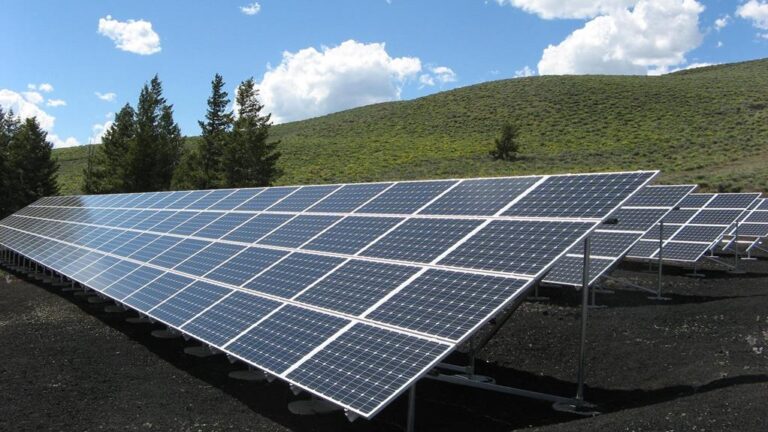Exploring Renewable Energy's Influence on Biodiversity
At the intersection of renewable energy and biodiversity lies a fascinating exploration of the effects and implications of sustainable power sources. The potential benefits are vast, from reducing greenhouse gas emissions to preserving our precious natural resources.
However, we must also acknowledge the challenges that arise, such as land-use conflicts and disruptions to wildlife populations.
As we delve into this topic, we aim to create a sense of belonging within our audience, fostering a shared understanding of the intricate connection between renewable energy and the diverse ecosystems it impacts.
By employing strategic approaches and technological advancements, we can minimize negative consequences and maximize the long-term benefits for both wildlife and humanity.
Let us embark on this journey of discovery and create a sustainable future together.
Positive Impacts on Biodiversity
Renewable energy promotes habitat preservation and fosters biodiversity through the reduction of greenhouse gas emissions. By transitioning to renewable energy sources, we can mitigate the environmental impacts caused by traditional energy production, benefiting wildlife and their habitats.
Renewable energy technologies, such as solar and wind power, have great potential to reduce greenhouse gas emissions while providing clean and sustainable energy. This shift towards renewable energy not only helps preserve natural resources but also supports wildlife conservation efforts. By reducing our reliance on fossil fuels, we can decrease air and water pollution, creating a healthier environment for wildlife to thrive.
The positive impacts of renewable energy on biodiversity are evident, as it offers a sustainable solution for energy production while safeguarding the delicate balance of ecosystems.
Negative Impacts on Biodiversity
The expansion of renewable energy infrastructure poses challenges for biodiversity conservation. While renewable energy projects aim to reduce greenhouse gas emissions and combat climate change, they can also have significant negative impacts on wildlife and ecosystems.
Wind turbines, for example, have been found to cause the deaths of millions of migratory birds and bats each year. Hydroelectric dams can disrupt fish migration routes and lead to high mortality rates for juveniles, impacting fish populations and the predators that rely on them. Concentrating solar plants, on the other hand, have been known to incinerate insects and birds with intense beams of sunlight, contributing to the loss of habitats.
Additionally, the mining of metals for renewable energy technologies can have adverse effects on biodiversity and exacerbate climate change. These environmental impacts must be carefully considered and mitigated to ensure that renewable energy infrastructure development aligns with biodiversity conservation efforts.
Wildlife Habitat and Ecosystem Impact
As we delve into the discussion of wildlife habitat and ecosystem impact, it’s important to consider the potential consequences of renewable energy development on biodiversity. The impacts of renewable energy on wildlife and ecosystems can be significant, and understanding these effects is crucial for effective conservation and sustainability efforts.
Here are three key points to consider:
- Large areas of land are often needed for renewable energy development, leading to habitat fragmentation or loss. This can disrupt wildlife populations and affect their ability to find food, mates, and suitable nesting sites.
- Migration routes of birds and bats can be obstructed by structures such as wind turbines, resulting in collisions and fatalities. This poses a threat to migratory species and can have cascading effects on ecosystem dynamics.
- Environmental impact assessments are essential for evaluating the potential risks of renewable energy projects and minimizing negative impacts. These assessments help identify sensitive areas and inform mitigation strategies to protect biodiversity.
Understanding the relationship between renewable energy development and wildlife habitat is crucial for balancing the need for clean energy with the conservation of biodiversity. By implementing responsible siting practices and incorporating biodiversity considerations into the planning process, we can minimize the threat to biodiversity and ensure a sustainable future for both energy and wildlife.
Strategies for Minimizing Impact
To effectively minimize the impact of renewable energy on biodiversity, we can employ various strategies.
One key strategy is the careful selection of sites for renewable energy projects. By considering the natural habitats and wildlife populations in an area, we can identify locations that will have the least negative impact on biodiversity.
Additionally, habitat restoration efforts can help mitigate the effects of renewable energy on wildlife. Restoring degraded habitats near renewable energy facilities can provide alternative habitats for displaced species.
Establishing buffer zones around renewable energy facilities is another effective strategy. These zones can act as a barrier, minimizing disturbance to wildlife populations.
Monitoring and research are vital in understanding and minimizing the impact of renewable energy on biodiversity. By continuously monitoring the impacts and collecting data, we can adjust strategies and implement measures to further minimize negative effects.
Technological advancements also play a crucial role in minimizing the impacts of renewable energy on wildlife habitats. Developing sustainable energy solutions like solar power plants and wind turbines that are designed with wildlife conservation in mind can greatly reduce their impact on biodiversity.
Lessons Learned for Coexistence
Our experience in minimizing the impact of renewable energy on biodiversity has taught us valuable lessons for coexistence. As we strive to transition away from fossil fuels and reduce our dependence on them, it’s crucial to consider the potential impacts on biodiversity and implement measures to mitigate those impacts.
Through research and collaboration with energy and wildlife experts, we’ve identified several key lessons:
- Recognizing the specific conservation concerns associated with different renewable energy sources is essential for effective conservation. Each source presents unique challenges that must be addressed to ensure the protection of wildlife.
- Involving local communities in the planning and implementation of renewable energy projects is vital for successful coexistence. By engaging with communities, we can better understand their needs and concerns, and develop strategies that benefit both energy production and biodiversity.
- Habitat restoration plays a crucial role in offsetting the impacts of renewable energy on biodiversity. By restoring and protecting habitats affected by energy development, we can provide vital resources for wildlife and promote their long-term survival.
These lessons learned can guide future efforts in energy and wildlife conservation, helping us achieve a sustainable balance between renewable energy production and the protection of biodiversity.
Conclusion
Our exploration of renewable energy’s influence on biodiversity has revealed a complex tapestry of both positive and negative impacts.
Like a delicate ecosystem, the transition to sustainable energy sources can bring forth blooming benefits, but also pose challenges that threaten the harmony of wildlife and their habitats.
By implementing strategic site selection, habitat restoration, and technological advancements, we can weave a future that harmonizes renewable energy and biodiversity, ensuring a vibrant symphony of life for generations to come.






